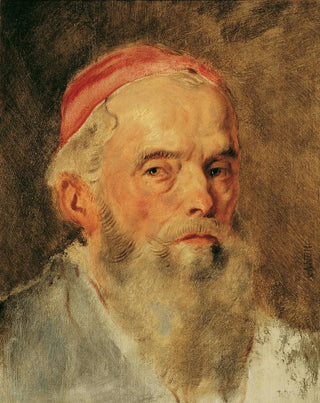Art print | Study of the head of the Loge Johannis - Hans Canon


View from behind

Frame (optional)
In the world of art, some works transcend their era to become timeless witnesses of culture and human thought. "Study of the Head of the Johannis Lodge" by Hans Canon is one of those creations that fascinate with their depth and symbolism. This painting, which delicately illustrates Masonic rituals, invites the viewer to delve into a universe filled with mystery and meaning. Through this work, Canon manages to capture not only the external appearance of his subjects but also the very essence of their spiritual and community engagement. The art print of this study allows for a rediscovery of a key moment in art history while offering a reflection on the values of fraternity and knowledge.
Style and uniqueness of the work
Hans Canon's work stands out for its realistic approach and its ability to render the human soul visible through portraiture. In "Study of the Head of the Johannis Lodge," the artist uses chiaroscuro techniques to emphasize facial features, creating an atmosphere that is both intimate and solemn. The nuances of light and shadow confer psychological depth to the characters, while the meticulous details of facial expressions reveal complex emotions. The composition is carefully orchestrated, with each element placed with precision that demonstrates Canon's craftsmanship. This painting does not merely depict an individual; it becomes the reflection of an idea, a philosophy, where each exchanged look among lodge members evokes a quest for truth and knowledge.
The artist and his influence
Hans Canon, an Austrian-born painter, established himself in the 19th-century art scene through his unique style and his ability to address various themes. Trained at the art schools of Vienna, Canon quickly developed a sensitivity for representing human subjects, especially in contexts charged with significance. His interest in Freemasonry and its rituals is clearly expressed in "Study of the Head of the Johannis Lodge," where he explores values of solidarity and initiation. Canon's influence extends beyond his time, as he paved the way

Matte finish

View from behind

Frame (optional)
In the world of art, some works transcend their era to become timeless witnesses of culture and human thought. "Study of the Head of the Johannis Lodge" by Hans Canon is one of those creations that fascinate with their depth and symbolism. This painting, which delicately illustrates Masonic rituals, invites the viewer to delve into a universe filled with mystery and meaning. Through this work, Canon manages to capture not only the external appearance of his subjects but also the very essence of their spiritual and community engagement. The art print of this study allows for a rediscovery of a key moment in art history while offering a reflection on the values of fraternity and knowledge.
Style and uniqueness of the work
Hans Canon's work stands out for its realistic approach and its ability to render the human soul visible through portraiture. In "Study of the Head of the Johannis Lodge," the artist uses chiaroscuro techniques to emphasize facial features, creating an atmosphere that is both intimate and solemn. The nuances of light and shadow confer psychological depth to the characters, while the meticulous details of facial expressions reveal complex emotions. The composition is carefully orchestrated, with each element placed with precision that demonstrates Canon's craftsmanship. This painting does not merely depict an individual; it becomes the reflection of an idea, a philosophy, where each exchanged look among lodge members evokes a quest for truth and knowledge.
The artist and his influence
Hans Canon, an Austrian-born painter, established himself in the 19th-century art scene through his unique style and his ability to address various themes. Trained at the art schools of Vienna, Canon quickly developed a sensitivity for representing human subjects, especially in contexts charged with significance. His interest in Freemasonry and its rituals is clearly expressed in "Study of the Head of the Johannis Lodge," where he explores values of solidarity and initiation. Canon's influence extends beyond his time, as he paved the way






